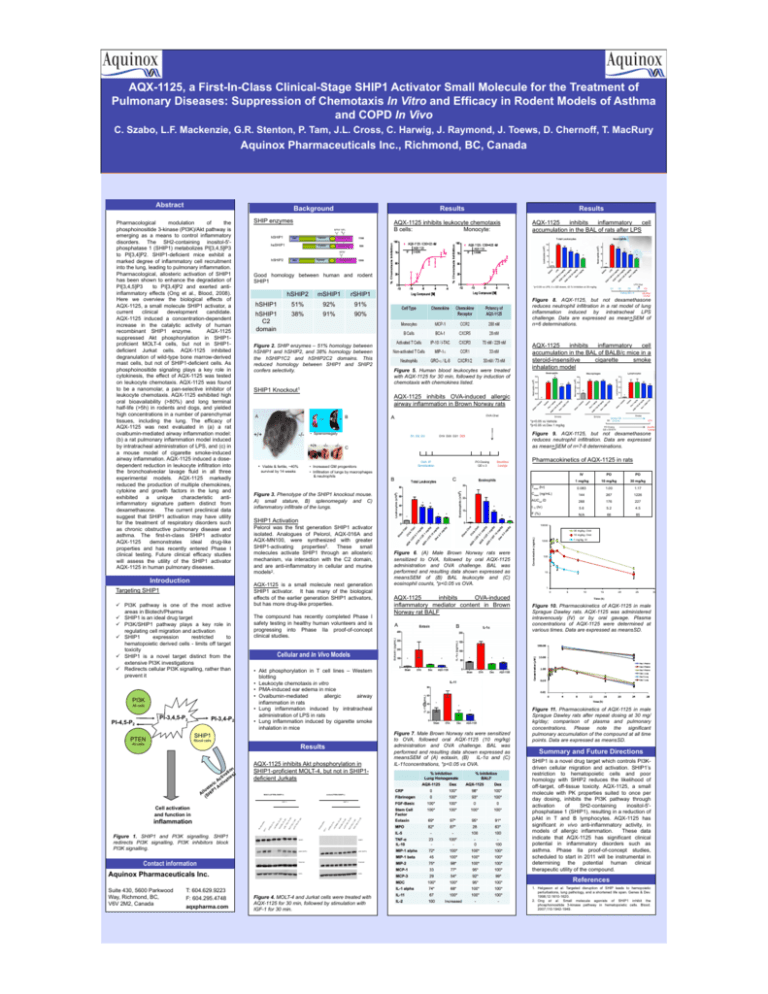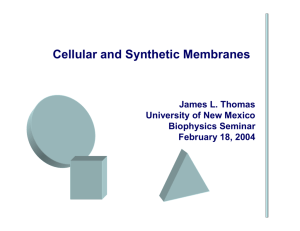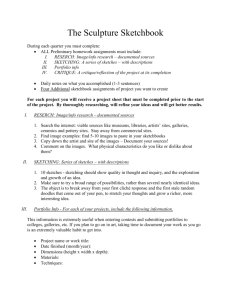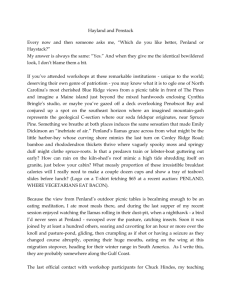AQX-1125, a First-In-Class Clinical
advertisement

AQX-1125, a First-In-Class Clinical-Stage SHIP1 Activator Small Molecule for the Treatment of Pulmonary Diseases: Suppression of Chemotaxis In Vitro and Efficacy in Rodent Models of Asthma and COPD In Vivo C. Szabo, L.F. Mackenzie, G.R. Stenton, P. Tam, J.L. Cross, C. Harwig, J. Raymond, J. Toews, D. Chernoff, T. MacRury Aquinox Pharmaceuticals Inc., Richmond, BC, Canada Abstract Background Introduction Targeting SHIP1 PI3K pathway is one of the most active areas in Biotech/Pharma SHIP1 is an ideal drug target PI3K/SHIP1 pathway plays a key role in regulating cell migration and activation SHIP1 expression restricted to hematopoietic derived cells - limits off target toxicity SHIP1 is a novel target distinct from the extensive PI3K investigations Redirects cellular PI3K signalling, rather than prevent it PI3K All cells PI-3,4,5-P3 PI-4,5-P2 PI-3,4-P2 AQX-1125 inhibits leukocyte chemotaxis B cells: Monocyte: NPNY NPL Y hSHIP1 SH2 hsSHIP1 5-ptase C2 NPNY NPLY Proline rich 5-ptase C2 Proline rich hSHIP2 5-ptase SH2 1188 C2 928 1258 Proline rich Good homology between human and rodent SHIP1 hSHIP2 mSHIP1 rSHIP1 hSHIP1 51% 92% 91% hSHIP1 C2 domain 38% 91% 90% Figure 2. SHIP enzymes – 51% homology between hSHIP1 and hSHIP2, and 38% homology between the hSHIP1C2 and hSHIP2C2 domains. This reduced homology between SHIP1 and SHIP2 confers selectivity. SHIP1 Knockout1 +/+ +/+ n io at ) tiv ors Ac at ic ctiv r e A st lo P1 A l SH I ( -/- +/+ +/+ • Viable & fertile, ~40% -/--/- D1, D2, D3 -/-/- Aquinox Pharmaceuticals Inc. Suite 430, 5600 Parkwood Way, Richmond, BC, V6V 2M2, Canada T: 604.629.9223 F: 604.295.4748 aqxpharma.com Figure 9. AQX-1125, but not dexamethasone reduces neutrophil infiltration. Data are expressed as mean+SEM of n=7-8 determinations. D19 D20 D21 D22 C • Increased GM progenitors • Infiltration of lungs by macrophages & neutrophils survival by 14 weeks OVA IP Sensitization B PO Dosing QD x 3 Sacrifice/ Lavage Pharmacokinetics of AQX-1125 in rats IV PO PO 1 mg/kg 10 mg/kg 30 mg/kg 0.083 1.00 1.17 Cmax (ng/mL) 144 267 1226 AUCinf /D 268 176 227 t ½ (hr) 5.6 5.2 4.5 F (%) N/A 66 85 C Tmax (hr) Figure 3. Phenotype of the SHIP1 knockout mouse. A) small stature, B) splenomegaly and C) inflammatory infiltrate of the lungs. SHIP1 Activation Pelorol was the first generation SHIP1 activator isolated. Analogues of Pelorol, AQX-016A and AQX-MN100, were synthesized with greater SHIP1-activating properties2. These small molecules activate SHIP1 through an allosteric mechanism, via interaction with the C2 domain, and are anti-inflammatory in cellular and murine models2. AQX-1125 is a small molecule next generation SHIP1 activator. It has many of the biological effects of the earlier generation SHIP1 activators, but has more drug-like properties. The compound has recently completed Phase I safety testing in healthy human volunteers and is progressing into Phase IIa proof-of-concept clinical studies. 10000 30 mg/kg, Oral 10 mg/kg, Oral Figure 6. (A) Male Brown Norway rats were sensitized to OVA, followed by oral AQX-1125 administration and OVA challenge. BAL was performed and resulting data shown expressed as mean±SEM of (B) BAL leukocyte and (C) eosinophil counts, *p<0.05 vs OVA. 1 mg/kg, IV 1000 100 10 1 0 AQX-1125 inhibits OVA-induced inflammatory mediator content in Brown Norway rat BALF B B A 5 10 15 20 25 Time (h) Figure 10. Pharmacokinetics of AQX-1125 in male Sprague Dawley rats. AQX-1125 was administered intravenously (IV) or by oral gavage. Plasma concentrations of AQX-1125 were determined at various times. Data are expressed as mean±SD. Cellular and In Vivo Models • Akt phosphorylation in T cell lines – Western blotting • Leukocyte chemotaxis in vitro • PMA-induced ear edema in mice • Ovalbumin-mediated allergic airway inflammation in rats • Lung inflammation induced by intratracheal administration of LPS in rats • Lung inflammation induced by cigarette smoke inhalation in mice Results AQX-1125 inhibits Akt phosphorylation in SHIP1-proficient MOLT-4, but not in SHIP1deficient Jurkats MOLT-4 (PTEN-/SHIP1+) Jurkat (PTEN-/SHIP1-) IGF-1 ) (0.1 25 ) µM ) ) µM ) µM µM 0 µM (10 (10 (1 25 11 11 AQ X- %) 25 0 (1 02 11 (0.1 50 40 29 AQ X- AQ X- 1 LY AQ X- DM SO IG F- ) ) No stim ulat ion ) ) µM ) µM (0.1 25 11 µM µM 0 µM (10 (10 (1 25 11 AQ X- %) 25 0 (1 02 11 (0.1 50 40 29 AQ X- AQ X- AQ X- stim ulat ion 1 LY DM SO IG F- No Contact information AQX-1125 inhibits inflammatory cell accumulation in the BAL of BALB/c mice in a steroid-insensitive cigarette smoke inhalation model OVA Chal A B -/- IGF-1 inflammation Figure 5. Human blood leukocytes were treated with AQX-1125 for 30 min, followed by induction of chemotaxis with chemokines listed. • Splenomegaly Cell activation and function in Figure 1. SHIP1 and PI3K signalling. SHIP1 redirects PI3K signalling, PI3K inhibitors block PI3K signalling. Figure 8. AQX-1125, but not dexamethasone reduces neutrophil infiltration in a rat model of lung inflammation induced by intratracheal LPS challenge. Data are expressed as mean+SEM of n=6 determinations. AQX-1125 inhibits OVA-induced allergic airway inflammation in Brown Norway rats A Blood cells All cells AQX-1125 inhibits inflammatory cell accumulation in the BAL of rats after LPS NPAY SHIP1 PTEN Results Results SHIP enzymes Concentration (ng/mL) Pharmacological modulation of the phosphoinositide 3-kinase (PI3K)/Akt pathway is emerging as a means to control inflammatory disorders. The SH2-containing inositol-5'phosphatase 1 (SHIP1) metabolizes PI[3,4,5]P3 to PI[3,4]P2. SHIP1-deficient mice exhibit a marked degree of inflammatory cell recruitment into the lung, leading to pulmonary inflammation. Pharmacological, allosteric activation of SHIP1 has been shown to enhance the degradation of PI[3,4,5]P3 to PI[3,4]P2 and exerted antiinflammatory effects (Ong et al., Blood, 2008). Here we overview the biological effects of AQX-1125, a small molecule SHIP1 activator, a current clinical development candidate. AQX-1125 induced a concentration-dependent increase in the catalytic activity of human recombinant SHIP1 enzyme. AQX-1125 suppressed Akt phosphorylation in SHIP1proficient MOLT-4 cells, but not in SHIP1deficient Jurkat cells. AQX-1125 inhibited degranulation of wild-type bone marrow-derived mast cells, but not of SHIP1-deficient cells. As phosphoinositide signaling plays a key role in cytokinesis, the effect of AQX-1125 was tested on leukocyte chemotaxis. AQX-1125 was found to be a nanomolar, a pan-selective inhibitor of leukocyte chemotaxis. AQX-1125 exhibited high oral bioavailability (>80%) and long terminal half-life (>5h) in rodents and dogs, and yielded high concentrations in a number of parenchymal tissues, including the lung. The efficacy of AQX-1125 was next evaluated in (a) a rat ovalbumin-mediated airway inflammation model: (b) a rat pulmonary inflammation model induced by intratracheal administration of LPS, and (c) in a mouse model of cigarette smoke-induced airway inflammation. AQX-1125 induced a dosedependent reduction in leukocyte infiltration into the bronchoalveolar lavage fluid in all three experimental models. AQX-1125 markedly reduced the production of multiple chemokines, cytokine and growth factors in the lung and exhibited a unique characteristic antiinflammatory signature pattern distinct from dexamethasone. The current preclinical data suggest that SHIP1 activation may have utility for the treatment of respiratory disorders such as chronic obstructive pulmonary disease and asthma. The first-in-class SHIP1 activator AQX-1125 demonstrates ideal drug-like properties and has recently entered Phase I clinical testing. Future clinical efficacy studies will assess the utility of the SHIP1 activator AQX-1125 in human pulmonary diseases. SHIP1 SHIP1 pAkt (S473) pAkt (S473) Total Akt Total Akt Actin Actin C Figure 7. Male Brown Norway rats were sensitized to OVA, followed oral AQX-1125 (10 mg/kg) administration and OVA challenge. BAL was performed and resulting data shown expressed as mean±SEM of (A) eotaxin, (B) IL-1α and (C) IL-11concentrations, *p<0.05 vs OVA. Figure 11. Pharmacokinetics of AQX-1125 in male Sprague Dawley rats after repeat dosing at 30 mg/ kg/day; comparison of plasma and pulmonary concentrations. Please note the significant pulmonary accumulation of the compound at all time points. Data are expressed as mean±SD. Summary and Future Directions SHIP1 is a novel drug target which controls PI3Kdriven cellular migration and activation. SHIP1’s restriction to hematopoietic cells and poor homology with SHIP2 reduces the likelihood of off-target, off-tissue toxicity. AQX-1125, a small molecule with PK properties suited to once per day dosing, inhibits the PI3K pathway through activation of SH2-containing inositol-5'phosphatase 1 (SHIP1), resulting in a reduction of pAkt in T and B lymphocytes. AQX-1125 has significant in vivo anti-inflammatory activity, in models of allergic inflammation. These data indicate that AQX-1125 has significant clinical potential in inflammatory disorders such as asthma. Phase IIa proof-of-concept studies, scheduled to start in 2011 will be instrumental in determining the potential human clinical therapeutic utility of the compound. References Figure 4. MOLT-4 and Jurkat cells were treated with AQX-1125 for 30 min, followed by stimulation with IGF-1 for 30 min. 1. Helgason et al. Targeted disruption of SHIP leads to hemopoietic perturbations, lung pathology, and a shortened life span. Genes & Dev. 1998;12:1610-1620. 2. Ong et al. Small molecule agonists of SHIP1 inhibit the phosphoinositide 3-kinase pathway in hematopoietic cells. Blood. 2007;110:1942-1949. 30







